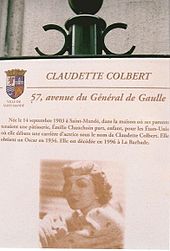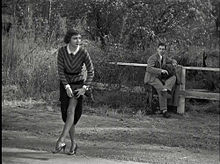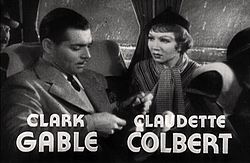- Claudette Colbert
-
Claudette Colbert 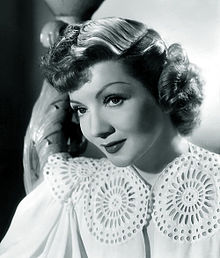
Claudette Colbert at her home in Paris, France in 1954Born Emilie Claudette Chauchoin
September 13, 1903
Paris, FranceDied July 30, 1996 (aged 92)
Speightstown, BarbadosOccupation Actress Years active 1923–1987 Spouse Norman Foster (1928–1935) (divorced)
Dr. Joel Pressman (1935–1968) (his death)Claudette Colbert (/koʊlˈbɛər/; 1903–1996) was a French-born American-based actress of stage and film.
Born in Paris, France and raised in New York City, Colbert began her career in Broadway productions during the 1920s, progressing to film with the advent of talking pictures. She established a successful film career with Paramount Pictures and later, as a freelance performer, became one of the highest paid entertainers in American cinema. Colbert was recognized as one of the leading female exponents of screwball comedy. She won the Academy Award for Best Actress for her comedic performance in It Happened One Night (1934), and also received Academy Award nominations for her dramatic roles in Private Worlds (1935) and Since You Went Away (1944).
Her film career began to decline in the 1950s, and she made her last film in 1961. Colbert continued to act in theater and, briefly, in television during her later years. After a career of more than 60 years' duration, Colbert retired to her home in Barbados, where she died at the age of 92, following a series of strokes.
Colbert received theatre awards from the Sarah Siddons Society, a lifetime-achievement award at the Kennedy Center Honors, and, in 1999, the American Film Institute placed her at number twelve on their "AFI's 100 Years... 100 Stars" list of the "50 Greatest American Screen Legends".[1]
Contents
Early life
Émilie Claudette Chauchoin[2][3] was born in Saint-Mandé, Seine, France,[4] to Georges Claude, a banker, and Jeanne Loew Chauchoin, a pastry cook.[5][6] After some financial reversals, her family emigrated to New York City in 1906.[6][7] Colbert eventually became a naturalized citizen of the U.S.[8]
Colbert studied at Washington Irving High School, where her speech teacher, Alice Rossetter, encouraged her to audition for a play she had written. Colbert made her stage debut at the Provincetown Playhouse in The Widow's Veil at the age of 15.
She attended the Art Students League of New York, intending to become a fashion designer, but appeared on the Broadway stage in a small role in The Wild Westcotts (1923). Inspired by her experience, Colbert ended her studies and embarked on a stage career in 1925.[9] She adopted the name "Claudette Colbert" as her stage name two years later; she had been using the name Claudette since high school.
Career
Broadway
After signing a five-year contract with the producer Al Woods, Colbert played ingenue roles on Broadway from 1925 through 1929. During her early years on stage, she fought against being typecast as a maid, and received critical acclaim on Broadway in the production of The Barker (1927), playing a carnival snake charmer. She later reprised this role for the play's run in London's West End.[10] Two other plays, See Naples and Die and Eugene O'Neill's Dynamo (1929), were unsuccessful. However, Colbert was noticed by the theatrical producer Leland Hayward, who suggested her for a role in Frank Capra's film For the Love of Mike (1927), now believed to be lost.[11] The film, Colbert's only silent film role, was a box office failure.[5]
Early film career
Colbert did not make any films for two years, but ultimately signed a contract with Paramount Pictures in 1928. Her earliest films were produced in New York, enabling her to continue her stage career. Her first sound film was The Hole in the Wall (1929), co-starring another newcomer, Edward G. Robinson. During production of her second sound film, The Lady Lies (also in 1929), Colbert was appearing nightly in the play See Naples and Die, which would be her final stage performance for 20 years.
In 1930 she appeared in the French language film Mysterious Mr. Parkes, one of the few foreign language films of the time to be widely screened in the United States, and she was also cast in The Big Pond. The latter was filmed in both French and English, and Colbert's fluency in both languages was a key consideration in her casting. She appeared opposite Maurice Chevalier, who commented of her, "She was lovely, brunette, talented and a delicious comedienne, and her English was perfect."[12] While these films were popular with audiences, one of her films from this period, Young Man of Manhattan, her only collaboration with her then-husband, Norman Foster, received negative notices. The magazine Picturegoer criticized Foster's performance and noted him as one of Colbert's weakest leading men, writing, "He did not seem to get any sincerity into his love scenes."[12]
She co-starred with Fredric March in Manslaughter (1930), and received positive reviews for her performance as a rich girl, jailed for vehicular manslaughter.[13] The New York Times wrote, "It cannot be denied that Claudette Colbert—given an even chance—is capable of excellent acting."[14] She was briefly paired with March, and they made four films together, including Dorothy Arzner's Honor Among Lovers (1931). She sang in her role opposite Maurice Chevalier in the Ernst Lubitsch musical The Smiling Lieutenant (1931), which was nominated for an Academy Award for Best Picture, and was acknowledged by critics for her ability to assert herself opposite the more experienced Miriam Hopkins.[12]
Cecil B. DeMille perceived Colbert as a femme fatale, and her films with him included partial nudity. (In the 1932 historical epic, The Sign of the Cross, she was cast opposite Fredric March as the Roman empress Poppaea. Glimpses of her bare breasts and nipples were visible in a scene where her character was bathing in asses' milk,[15] a scene that came to be regarded as an example of Hollywood decadence prior to the enforcement of the Production Code).[16] Later that year, she played in The Phantom President. In 1933, Colbert renegotiated her contract with Paramount to allow her to appear in films for other studios.
Breakthrough
During 1934, Colbert's film career flourished. Of the four films she made that year, three of them—the historical biography, Cleopatra, the romantic drama, Imitation of Life, and the screwball comedy, It Happened One Night—were nominated for Academy Awards for Best Picture.
Colbert was reluctant to appear as the "runaway heiress", Ellie Andrews, in the Frank Capra romantic comedy, It Happened One Night (1934), opposite Clark Gable and released by Columbia Pictures. Behind schedule after several actresses had refused the role, the studio accepted Colbert's demand that she be paid $50,000 and that filming was to be completed within four weeks to allow her to take a planned vacation. Colbert felt that the script was weak, and Capra recalled her dissatisfaction, commenting, "Claudette fretted, pouted and argued about her part... she was a tartar, but a cute one."[17]
The film contained at least one scene that is often cited as representative of the screwball film genre and which became well known, even by people who had not seen the entire film.[18][19] Stranded in the countryside, Colbert demonstrates to an astonished Gable how to hitchhike by displaying her leg. Colbert won the Academy Award for Best Actress for her role. The film was the first to sweep all five major Academy Awards, including Best Picture, Best Director and Best Actor, and was a resounding box-office success. In later life, Colbert reflected upon her misgivings about the film and her lack of confidence when it was completed, commenting, "I left wondering how the movie would be received. It was right in the middle of the Depression. People needed fantasy, they needed splendor and glamour, and Hollywood gave it to them. And here we were, looking a little seedy and riding on our bus".[20]
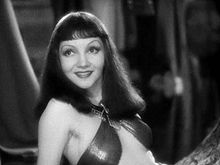 In Cleopatra (1934)
In Cleopatra (1934)
In Cleopatra (1934), she played the title role opposite Warren William. Thereafter, Colbert did not wish to be portrayed as overtly sexual and later refused such roles.[21]
Post-1934
Colbert's success allowed her to renegotiate her contract, raising her salary. In 1935 and 1936, she was listed in the annual "Quigley Poll of the Top Ten Money Making Stars", which was compiled from the votes of movie exhibitors throughout the U.S. for the stars who had generated the most revenue in their theaters over the previous year.[22] She received a second Academy Award nomination for her role in the hospital drama, Private Worlds (1935).
In 1936, Colbert signed a new contract with Paramount Pictures, which required her to make seven films over a two-year period, and this contract made her Hollywood's highest paid actress.[23] This was followed by a contract renewal in 1938, after which she was reported to be the highest paid performer in Hollywood with a salary of $426,924.[24] Her films during this period include The Gilded Lily (1935) and The Bride Comes Home (1935) with Fred MacMurray, She Married Her Boss (1935) with Melvyn Douglas, Under Two Flags (1936) with Ronald Colman, Maid of Salem (1937), again with MacMurray, Tovarich (1937) with Charles Boyer, Bluebeard's Eighth Wife (1938) with Gary Cooper, Zaza (1939) with Herbert Marshall, Midnight (1939) with Don Ameche, and It's a Wonderful World (1939) with James Stewart.
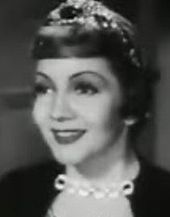 In the film Tovarich (1937)
In the film Tovarich (1937)
With her success, Colbert was able to assert control over the manner in which she was portrayed and gained a reputation for being fastidious by refusing to be filmed from her right side. She believed that her face was uneven and photographed better from the left. She learned about lighting and cinematography, and refused to begin filming until she was satisfied that she would be shown to her best advantage. One example of Colbert's determination to control the way she was photographed occurred during the filming of Tovarich in 1937, when one of her favored cameramen was dismissed by the director, Anatole Litvak. After seeing the rushes filmed by the replacement, Colbert refused to continue. She insisted on hiring her own cameraman, and offered to waive her salary if the film went over budget as a result.[23] Drums Along the Mohawk (1939) with Henry Fonda was Colbert's first color film. However, she distrusted the relatively new Technicolor process and feared that she would not photograph well, preferring thereafter to be filmed in black and white.[25]
During this time she began acting for CBS' popular Lux Radio Theater, making numerous appearances between 1935 and 1954.[26]
Later film career
In 1940, Colbert refused a seven-year contract that would have paid her $200,000 a year, as she had found that she could command a fee of $150,000 per film as a freelance artist. With her brother as her manager, Colbert was able to secure roles in prestigious films, and this period marked the height of her earning ability.[23] In the early 1940s she starred in such films as Boom Town (1940), with Clark Gable, Spencer Tracy, and Hedy Lamarr; Arise, My Love (1940), with Ray Milland; and the Preston Sturges comedy The Palm Beach Story (1942), opposite Joel McCrea.
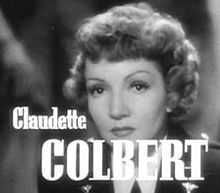 In So Proudly We Hail! (1943)
In So Proudly We Hail! (1943)
After more than a decade as a leading actress, Colbert began to make a transition to more mature characters, though she was reportedly very sensitive about her age. During filming of So Proudly We Hail! (1943), with Paulette Goddard and Veronica Lake, a rift occurred when Colbert overheard a remark made by Goddard in an interview. Asked which of her costars she preferred, Goddard had replied, "Veronica, I think. After all, we are closer in age." (Actually, Goddard (b. 1910) was 12 years older than Lake (b. 1922) and only 7 years younger than Colbert (b. 1903), making her considerably closer in age to Colbert, so this may have been an intentional slight). Goddard further commented that Colbert "flipped" and "was at Paulette's eyes at every moment," and said that they continued their feud throughout the duration of filming.[27]
Impressed by her performance in this film, but aware of Colbert's sensitivity, David O. Selznick approached her to play the lead role in Since You Went Away (1944). She balked at the prospect of playing a mother of teenaged children, but Selznick believed that she was the best candidate for the role. He valued her marketability, commenting that "even light little comedies with her have never done under a million and a half."[28] Eventually, Colbert accepted. The director, John Cromwell, later noted that Colbert was "level headed, very professional and with no temperament", but Selznick expressed frustration with some of her demands. He wrote in a memo to Colbert's agent that they had rebuilt several sets "because of her refusal to have the right side of her face photographed, on top of which we have to pay her not only a fabulous salary, but also give her two days off a month, which works out to $5000 every four weeks for doing absolutely nothing, and now she's demanding three.... Tell her there's a war on and we all have to make some sacrifices."[29]
Released in June 1944, the film became a substantial success and grossed almost $5 million in the United States. The critic James Agee praised aspects of the film, but particularly Colbert's performance, writing, "Selznick has given Claudette Colbert the richest, biggest role of her career. She rewards him consistently with smooth Hollywood formula acting, and sometimes, in collaboration with (Joseph) Cotten, with flashes of acting that are warmer and more mature."[30] Colbert received her final Academy Award nomination for this performance.
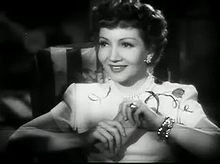 In The Secret Heart (1946)
In The Secret Heart (1946)
In 1945, Colbert ended her association with Paramount Studios, and continued to free-lance in such films as Guest Wife (1945), with Don Ameche. RKO Studios hired her to appear opposite John Wayne in Without Reservations (1946), with a storyline and setting intentionally inspired by It Happened One Night.[31] Without Reservations grossed $3 million in the U.S.,[32] and the overall popularity of Colbert's films during 1946 led to her making a final appearance in the "Quigley Poll of the Top Ten Money Making Stars".[22] She achieved her last great success opposite Fred MacMurray in the comedy The Egg and I (1947). The film was one of the year's biggest hits, and was later acknowledged as the 12th most profitable American film of the 1940s.[33] Her subsequent films failed to capitalize on her renewed success, with the exception of the suspense film Sleep, My Love (1948) with Robert Cummings.
Colbert lost two roles originally intended for her, and which were highly successful ventures for each of the actresses who replaced her. She was signed to appear in State of the Union with Gary Cooper, who was replaced by Spencer Tracy. Two days before filming began, Colbert advised the director Frank Capra that she was unable to work beyond 5 p.m. each day, citing "doctor's orders". Capra refused to accommodate her terms and cast Katharine Hepburn in the role.[34]
In 1949, Joseph L. Mankiewicz wrote the part of Margo Channing in All About Eve for Colbert, feeling that she best represented the style of the older actress he envisioned for the part. Mankiewicz admired her "sly wit and sense of class" and felt that she would play the part as an "elegant drunk", who would easily win the support of the audience. Colbert was enthusiastic about the role, and after a succession of noble roles, relished the prospect of playing what she described as a more "feline" character. Before production started, Colbert severely injured her back, while filming a scene for Three Came Home. Although 20th Century Fox postponed the production of All About Eve for two months while she convalesced, she was still not fit enough to take the role and was replaced by Bette Davis. Years later, Mankiewicz commented that he still imagined how effectively Colbert would have embodied the role, and how greatly her portrayal would have differed from Davis's.[35] Colbert described her loss of the role as one of her great regrets, and said that she wished she could have played the role, even if it had been "in a wheelchair".[36]
Her films of this period received mixed reception. The RKO comedy Bride for Sale, in which Colbert was part of a love triangle that included George Brent and Robert Young, was well reviewed and modestly successful. The Secret Fury (1950), also for RKO, was a mystery melodrama that was widely panned, with one critic commenting that Colbert and her co-star Robert Ryan "wandered through the film like two abandoned children in search of their father".[37]
Decline of film career
In the early 1950s, Colbert traveled to Europe and began making fewer films. She appeared in the French film Royal Affairs in Versailles, one of only two films she made in her native country, and a success at the local box-office.[38] Colbert had a supporting role rather than top billing in the film, which also featured a number of well known French cinema performers.[39]
In 1954, after a successful appearance in a television version of The Royal Family, she began acting in various teleplays. From 1954 to 1960, she appeared in the television adaptations of Blithe Spirit in 1956 and The Bells of St. Mary's in 1959. She also guest starred on Robert Montgomery Presents, Playhouse 90, and Zane Grey Theater.
In 1958, she returned to Broadway in The Marriage-Go-Round, for which she was nominated for a Best Actress Tony Award.
By 1955 she had stopped making films, although returned to the screen in Parrish (1961) for Warner Brothers. When the film was released, most of the studio publicity was in support of the young male lead Troy Donahue, who was being groomed by the studio. Colbert, playing the supporting role of Donahue's mother, received little attention, and the film was not a success. She never made another film although the press occasionally referred to upcoming projects that did not exist. Embarrassed, Colbert instructed her agent to stop his attempts to generate interest in her as a film actress. In the late 1960s, a reporter asked her why she had made no more films, to which she replied, "Because there have been no offers."[40]
Her occasional acting ventures were limited to theater and included performances on Broadway and in London in The Irregular Verb to Love (1963); The Kingfisher (1978) in which she co-starred with Rex Harrison, and Frederick Lonsdale's Aren't We All? (1985) also with Rex Harrison.
In 1987, Colbert appeared in a supporting role in the television miniseries The Two Mrs. Grenvilles. The production was a ratings success and was nominated for several awards. Colbert won a Golden Globe and received a nomination for an Emmy Award. This marked her final performance on film, however she continued to act in theater.
Personal life
In 1928, Colbert married Norman Foster, an actor and director, who appeared with Colbert in the Broadway show The Barker. She and her first husband lived apart, never sharing a home together in Hollywood[41], supposedly because Colbert's mother disliked Foster and would not allow him into their home.[42] Colbert and Foster divorced in 1935.
In December of that year, Colbert married Dr. Joel Pressman, a surgeon at UCLA.[5] The marriage lasted 33 years, until Pressman's death of liver cancer in 1968.
Colbert had one brother, Charles (1898–1971), who used the surname Wendling and served as her agent and business manager for a time.[6] He is credited with negotiating some of her more lucrative contracts in the late 1930s and early 1940s.[12]
Colbert was a staunch Republican and conservative.[43]
Final years and death
For years, Colbert divided her time between her apartment in Manhattan and her summer home in Speightstown, Barbados.[5] After suffering a series of strokes in 1993, she took up permanent residence at her home in Barbados, where she died on July 30, 1996, at age 92.[5] Colbert is buried in the Parish of St. Peter Cemetery in Barbados.[44] Colbert left no immediate family.[5]
The bulk of Colbert's estate was left to a friend, Helen O'Hagan, a retired director of corporate relations at Saks Fifth Avenue, whom Colbert had met in 1961 on the set of the her last film. O'Hagan cared for Colbert following her 1993 strokes.[45]
Contemporary reception
Colbert established one of the most successful film careers of any actress of her generation, and was considered a dependable and bankable star. Her status was reflected in her earnings as one of the best paid performers of the 1930s and 1940s. Colbert once commented that she had sacrificed for the sake of her career. In discussing Colbert's career, her contemporaries confirmed her drive. Irene Dunne commented that she had lacked Colbert's "terrifying ambition" and noted that if Colbert "finished work on a film on a Saturday, she would be looking for a new project by Monday". Hedda Hopper wrote that Colbert placed her career "ahead of everything save possibly her marriage", and described her as the "smartest and canniest" of Hollywood actresses, with a strong sense of what was best for her, and a "deep rooted desire to be in shape, efficient and under control".[27]
Other actors admired Colbert's comic timing; David Niven related in his biography that Gary Cooper was "terrified" at the prospect of working with Colbert in his first comedy, Bluebeard's Eighth Wife, because he considered Colbert to be an expert in the genre. The film gave Niven one of his first significant parts, and he wrote that Colbert took a nurturing role towards him and "was the soul of fun and a most generous performer," although he noted that her insistence that she be filmed only from her left side created difficulties for the cameramen.[46] Her fastidious attitude in this regard became well known, with Doris Day quoted as saying, "God wasted half a face on Claudette". During her heyday, film technicians described the right side of her face as "the dark side of the moon."[27] In a 1930s interview Constance Bennett replied to questions about her own demands, with the comment that Colbert's idiosyncrasies were far more excessive, but Bennett acknowledged that it was an integral part of Colbert's success.[23] Colbert was generally respected for her professionalism, with the New York Times stating that she was known for giving "110 percent" to any project she worked on, and she was highly regarded for learning the technical aspects of studio lighting and cinematography that allowed her to maintain a distinctive film image.[23] In her biography, Myrna Loy stated that Colbert, along with Joan Crawford, "knew more about lighting than the experts did."[47]
Modern critics and film historians note that Colbert demonstrated versatility throughout her career, and played characters that ranged from vamps to housewives, and that encompassed screwball comedy and drama.[23] Pauline Kael wrote that Colbert was widely admired by American audiences from the time of It Happened One Night because she represented "Americans' idealized view of themselves—breezy, likable, sexy, gallant and maybe just a little hare-brained."[18]
Colbert found it difficult to make the transition to playing more mature characters as she approached middle-age and expressed her admiration for Bette Davis. Colbert noted that Davis had made the transition more easily because she had shrewdly played character roles as a young woman.[27] Praised for her sense of style and awareness of fashion, Colbert ensured throughout her career that she was impeccably groomed and costumed. For the 1946 melodrama, Tomorrow is Forever, Jean Louis was hired to create eighteen changes of wardrobe for her.[48]
When Colbert received a Kennedy Center Honor, her fashion sense was referred to with a quotation from Jeanie Basinger in The International Dictionary of Films and Filmmakers: "[Her] glamour is the sort that women attain for themselves by using their intelligence to create a timeless personal style."[49] The writer A. Scott Berg described Colbert as one of Paramount Studio's greatest assets, as she had "proved deft in all genres" and had "helped define femininity for her generation with her chic manner."[50]
She is cited as a leading female exponent of screwball comedy, along with such actresses as Jean Arthur, Irene Dunne, Carole Lombard, Myrna Loy and Rosalind Russell. In her comedy films, she invariably played shrewd and self-reliant women, but unlike many of her contemporaries, Colbert rarely engaged in physical comedy. Her characters were more likely to be observers and commentators.[51]
Filmography
Further information: Claudette Colbert chronology of performancesAwards and honors
Colbert was nominated for the Academy Award for Best Actress for three films, It Happened One Night (1935), Private Worlds (1936), and Since You Went Away (1945), winning for It Happened One Night. In addition, she won a Golden Globe Award for Best Supporting Actress in a Series, Mini-series, or Motion Picture Made for Television for her role in The Two Mrs. Grenvilles (1988), and was nominated for an Emmy Award for the same.
Claudette Colbert remains the only actress in the history of cinema to star in three films in the same year to be nominated for Best Picture Academy Award, those films being Cleopatra, Imitation of Life, and It Happened One Night which were all made in 1934.[citation needed] In 2002, John C. Reilly starred in The Hours, Chicago, and Gangs of New York, each of which was similarly nominated for Best Picture.
In 1980, Colbert was awarded the Sarah Siddons Award for her theatre work.[52] In 1984, Colbert was awarded the Gala Tribute award by the Film Society of Lincoln Center.[53] The same year, a building at the old Kaufman Astoria Studios in New York, where she had made ten films in early career, was renamed in her honor.[54] In 1985, Colbert was awarded a Drama Desk Special Award.[55]
In 1989, Colbert received Kennedy Center Honors for lifetime achievement.[49] In 1990, Colbert was honored with the San Sebastián International Film Festival Donostia Lifetime Achievement Award.[56]
For her contribution to the motion picture industry, Claudette Colbert has a star on the Hollywood Walk of Fame at 6812 Hollywood Blvd.[57]
References
- ^ "AFI's 100 Years, 100 Stars, American's Greatest Legends" (PDF). American Film Institute. http://www.afi.com/Docs/tvevents/pdf/stars50.pdf. Retrieved 2008-01-18.
- ^ Larousse Encyclopedia : Claudette Colbert[dead link]
- ^ "Claudette Colbert" (in French). lesgensducinema.com. http://www.lesgensducinema.com/affiche_acteur.php?mots=claudette+colbert&nom_acteur=COLBERT%20Claudette&ident=28925&debut=0&record=0&from=ok.
- ^ COLBERT, Claudette. British Film Institute. BFI.org.uk.
- ^ a b c d e f Pace, Eric (1996-07-31). "Claudette Colbert, Unflappable Heroine of Screwball Comedies, is Dead at 92". The New York Times: p. 2. http://query.nytimes.com/gst/fullpage.html?res=9802E6D91439F932A05754C0A960958260.
- ^ a b c Quirk, Claudette Colbert, p. 5.
- ^ Ellis Island History: Some Were Destined For Fame. Ellis Island National Park. Accessed: 19 January 2008.
- ^ "Famous Naturalized U.S. Citizens". http://72.14.235.104/search?q=cache:eG6fWFfBoEIJ:www.nclr.org/files/48390_file_naturalized_US_citizens_factsheet.pdf+Claudette+Colbert+naturalized+citizen&hl=en&ct=clnk&cd=6. Retrieved 2007-10-30.
- ^ Claudette Colbert — Filmography — New York Times.
- ^ Basinger, Jeanine; Audrey E. Kupferberg. "Claudette Colbert — Films as actress:". http://www.filmreference.com/Actors-and-Actresses-Ca-Co/Colbert-Claudette.html. Retrieved 2007-12-03.
- ^ Classic Film Guide.
- ^ a b c d Shipman, The Great Movie Stars, p. 113.
- ^ Manslaughter at AllRovi
- ^ Quirk, p. 64 citing The New York Times.
- ^ Springer, p. 62.
- ^ Edwards, p. 121.
- ^ Hirschnor, p. 87.
- ^ a b Kael, p. 285.
- ^ Edmonds and Mimura, p. 48.
- ^ Harris, pp. 112–114.
- ^ Chaneles, p. 97.
- ^ a b "The 2006 Motion Picture Almanac, Top Ten Money Making Stars". Quigley Publishing Company. http://www.quigleypublishing.com/MPalmanac/Top10/Top10_lists.html. Retrieved 2006-08-18.
- ^ a b c d e f Shipman, The Great Movie Stars, p. 115.
- ^ Karney, p. 53.
- ^ Finler, p. 24.
- ^ "Audio Classics Archive Radio Logs: Lux Radio Theater". http://www.audio-classics.com/lluxradio.html. Retrieved 2007-11-23.
- ^ a b c d Shipman, Movie Talk, p. 126.
- ^ Haver, pp. 338–340.
- ^ Haver, pp. 340–341.
- ^ Haver, p. 342.
- ^ Jewell and Harbin, p. 211.
- ^ "Without Reservations: Business and Box Office Data." IMDB.com.
- ^ Finler, p. 216.
- ^ Anderson, pp. 191–192.
- ^ Staggs, pp. 59–60.
- ^ Chandler, p. 184.
- ^ Jewell and Harbin, p. 248.
- ^ IMDB Royal Affairs at Versailles: Business and Box Office Data
- ^ Soares, Andre (January 12, 2005). "Best Films – 1954". Alternative Film Guide. http://www.altfg.com/blog/best-films-of/best-films-of-1954/.
- ^ Shipman, The Great Movie Stars, p. 117.
- ^ Claudette Colbert at the TCM Movie Database
- ^ DiLeo, John (October 5, 2008-10-05). "Star Light, Star Bright". Washington Post: p. BW08. http://www.washingtonpost.com/wp-dyn/content/story/2008/10/03/ST2008100302864.html. Retrieved 2008-10-08.
- ^ Granger, Derek (1996-08-02). "Obituary: Claudette Colbert". The (London) Independent.
- ^ Claudette Colbert at Find A Grave.
- ^ Rush, George, and Salvatore Arena. "Colbert Leaves 3.5M Estate to a Life-Long Pal", New York Daily News, 9 August 1996.
- ^ Niven, p. 286.
- ^ Kotsilibas-Davis and Loy, p. 119.
- ^ Jewell and Harbin, p. 209.
- ^ a b "The Kennedy Center, Biography of Claudette Colbert". http://www.kennedy-center.org/calendar/index.cfm?fuseaction=showIndividual&entity_id=3708&source_type=A. Retrieved 2008-01-19.
- ^ Berg, p. 190.
- ^ DiBattista, p. 210.
- ^ "Sarah Siddons Society Awardees". http://www.sarahsiddonssociety.org/html/Awardees.html. Retrieved 2008-01-18.
- ^ Robertson, Nan. "Film Society of Lincoln Center". New York Times. http://topics.nytimes.com/top/reference/timestopics/organizations/f/film_society_of_lincoln_center/index.html?query=COLBERT,%20CLAUDETTE&field=per&match=exact. Retrieved 2008-01-18.
- ^ Garcia, Gary D. (16 April 1984). "Time: People". Time Magazine. http://www.time.com/time/magazine/article/0,9171,954273,00.html. Retrieved 2007-02-11.
- ^ Drama Desk Award winners.
- ^ "Archive of awards, juries and posters". San Sebastián International Film Festival. http://www.sansebastianfestival.com/2007/in3/premios10_1990.php. Retrieved 2008-01-18.
- ^ "Hollywood Chamber of Commerce, Walk of Fame, Claudette Colbert". http://www.tibp.com/cgi-bin/foxweb.dll/wlx/dir/wlxdirectory?cc=WOFAME. Retrieved 2008-01-18.
Bibliography
- Anderson, Christopher (1997). An Affair to Remember, The Remarkable Love Story of Katharine Hepburn and Spencer Tracy. William Morrow and Co. Inc. ISBN 0-688-15311-9
- Berg, A. Scott (1989). Goldwyn. Sphere Books. ISBN 0-7474-0593-X
- Chandler, Charlotte (2006). The Girl Who Walked Home Alone, Bette Davis, A Personal Biography. Simon & Schuster. ISBN 0-7432-6208-5
- Chaneles, Sol (1974). The Movie Makers. Octopus Books. ISBN 0-7064-038708
- DiBattista, Maria (2001). Fast Talking Dames. Yale University Press. ISBN 0-300-09903-7
- Edmonds, I. G. and Mimura, Reiko (1980). The Oscar Directors. Tantivy Press. ISBN 0-498-02444-X
- Edwards, Anne (1988). The DeMilles, An American Family. William Collins, Sons & Co. ISBN 0-00-215241-X
- Finler, Joel W. (1989). The Hollywood Story: Everything You Always Wanted to Know About the American Film Industry But Didn't Know Where to Look. Pyramid Books. ISBN 1-855-10009-6
- Harris, Warren G. (2002). Clark Gable, A Biography. Aurum Press. ISBN 1-85410-904-9
- Haver, Ronald (1980). David O. Selznick's Hollywood. Bonanza Books, New York. ISBN 0-517-47665-7
- Hirschnor, Joel (1983). Rating the Movie Stars for Home Video, TV and Cable. Publications International Limited. ISBN 0-88176-152-4
- Jewell, Richard B. and Harbin, Vernon (1982). The RKO Story, Octopus Books. ISBN 0-7064-1285-0
- Kael, Pauline (1984). 5001 Nights at the Movies. Zenith Books. ISBN 0-09-933550-6
- Karney, Robyn (1984). The Movie Stars Story, An Illustrated Guide to 500 of the World's Most Famous Stars of the Cinema. Octopus Books. ISBN 0-7064-2092-6
- Kotsilibas-Davis and Loy, Myrna (1988). Being and Becoming. Donald I. Fine Inc. ISBN 1-556611-101-0
- Niven, David (1976). Bring on the Empty Horses. Putnam. ISBN 0-399115-420-0
- Quirk, Lawrence J. (1974). Claudette Colbert An Illustrated Biography. Crown Publishers. ISBN 0-517-55678-2
- Shipman, David (1970). The Great Movie Stars: The Golden Years. Bonanza Books, New York. Library of Congress Catalogue Card Number 78-133803
- Shipman, David (1988). Movie Talk. St. Martin's Press. ISBN 0-312-03403-2
- Springer, John (1978). They Had Faces Then, Annabella to Zorina, the Superstars, Stars and Starlets of the 1930s. ISBN 0-8065-0657-1
External links
- Claudette Colbert at the Internet Broadway Database
- Claudette Colbert at the Internet Movie Database
- Claudette Colbert at the TCM Movie Database
- Claudette Colbert at AllRovi
Hosts of the Academy Awards ceremonies (1941–1960) Bob Hope (1941) · None (1942) · Bob Hope (1943) · Jack Benny (1944) · Bob Hope / John Cromwell (1945) · Bob Hope / James Stewart (1946) · Jack Benny (1947) · Dick Powell / Agnes Moorehead (1948) · Robert Montgomery (1949) · Paul Douglas (1950) · Fred Astaire (1951) · Danny Kaye (1952) · Bob Hope / Conrad Nagel (1953) · Donald O'Connor / Fredric March (1954) · Bob Hope / Thelma Ritter (1955) · Jerry Lewis / Claudette Colbert / Joseph L. Mankiewicz (1956) · Jerry Lewis / Celeste Holm (1957) · Bob Hope / David Niven / James Stewart / Jack Lemmon / Rosalind Russell (1958) · Bob Hope / David Niven / Tony Randall / Mort Sahl / Laurence Olivier / Jerry Lewis (1959) · Bob Hope (1960)
Complete list · (1927–1940) · (1941–1960) · (1961–1980) · (1981–2000) · (2001–2020) Categories:- 1903 births
- 1996 deaths
- People from Saint-Mandé
- American people of French descent
- American film actors
- American stage actors
- Art Students League of New York alumni
- Best Actress Academy Award winners
- Best Supporting Actress Golden Globe (television) winners
- California Republicans
- Disease-related deaths in Barbados
- French emigrants to the United States
- Kennedy Center honorees
- Naturalized citizens of the United States
- New York Republicans
- 20th-century actors
Wikimedia Foundation. 2010.

